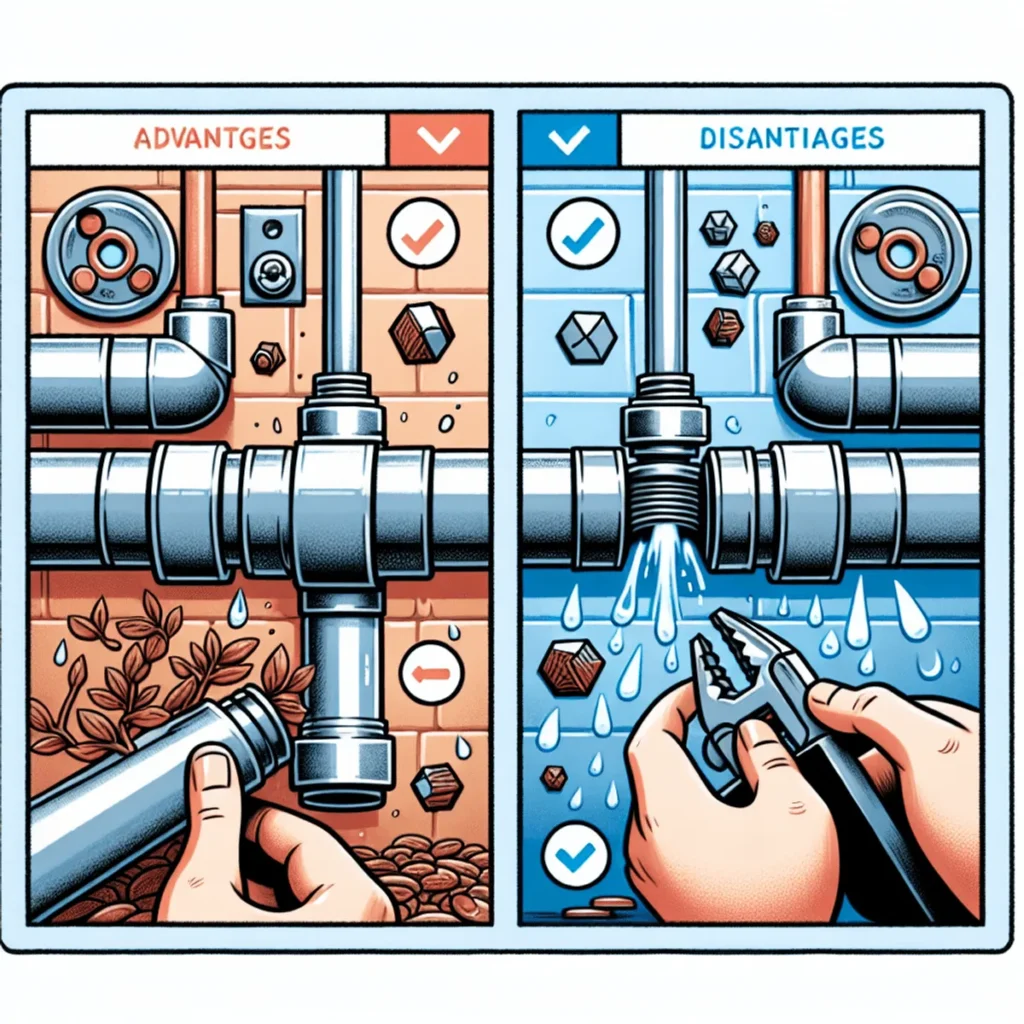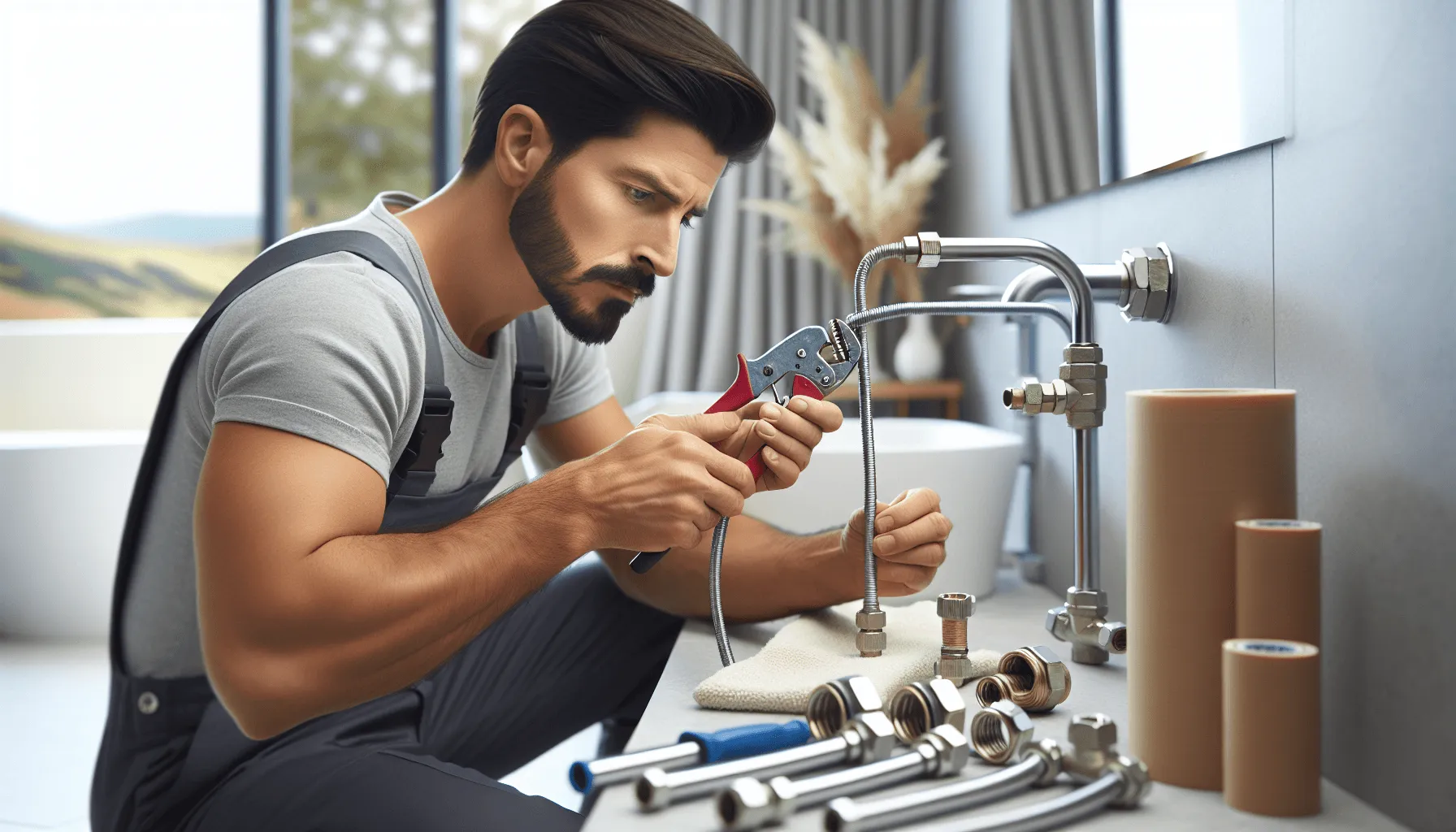PEX (cross-linked polyethylene) has become a popular choice for plumbing because it’s flexible, doesn’t rust, and is easy to install. It’s gaining popularity because it can be used in many ways and lasts longer than traditional materials like copper or PVC.
When working with PEX tubing, you have two main types of fittings to choose from: crimp fittings and expansion fittings. Crimp fittings use a copper or stainless steel ring that is compressed around the pipe, while expansion fittings involve expanding the end of the PEX-A pipe before inserting an expansion fitting.
In this article, we’ll compare PEX expansion vs crimp fittings. We’ll look at the details of each type, weighing their pros and cons to help you make an informed decision for your plumbing projects. Whether you’re a DIY enthusiast or a professional plumber, understanding the differences between PEX expansion and crimp fittings will help you choose the best plumbing solution for your needs.
Understanding PEX Fittings
PEX, or cross-linked polyethylene, is a versatile plumbing material known for its flexibility, corrosion resistance, and ease of installation. Unlike traditional materials like copper or PVC, PEX doesn’t corrode or develop pinhole leaks. Its flexibility allows it to be bent around corners without the need for additional fittings, reducing both installation time and cost.
Types of PEX Fittings
There are several types of PEX fittings available, but the two most common are crimp fittings and expansion fittings.
1. Crimp Fittings
- Use a copper or stainless steel crimp ring compressed around the pipe.
- Compatible with all types of PEX (A, B, C).
- Follow ASTM standards (F1807 for metal and F2159 for plastic).
- Require crimp tools and calibration tools like go-no-go gauges.
2. Expansion Fittings
- Involve expanding the end of a PEX-A pipe using specialized expansion tools.
- Specifically, work with PEX-A tubing.
- Follow ASTM F1960 standards.
- Typically more expensive and requires professional installation.
Importance of Selecting the Right Fitting
Choosing between PEX crimp vs expansion fittings depends on various factors:
- Ease of Installation: Crimp fittings offer straightforward installation with immediate testing capabilities. Expansion fittings require specialized tools and waiting periods but may provide better long-term performance.
- Cost: Crimp fittings generally have lower upfront costs compared to expansion fittings.
- Performance: Expansion fittings often allow for better water flow rates due to their larger internal diameter.
Understanding these differences helps you make an informed decision tailored to your specific plumbing needs. Whether choosing a PEX crimp ring vs expansion fitting, knowing the pros and cons will ensure your plumbing system’s efficiency and durability.
Crimp Fittings: An In-Depth Look
Crimp fittings are a popular choice for connecting PEX pipes due to their reliability and simplicity. These fittings work by compressing a copper crimp ring around the PEX pipe, ensuring a tight seal.
Materials Used
- Copper Crimp Rings: The most common material, known for its durability and strength.
- Stainless Steel Crimp Rings: Offers corrosion resistance, making them suitable for areas with harsh water conditions.
Compliance with ASTM standards is crucial for ensuring the quality and reliability of crimp fittings. Specifically:
- ASTM F1807: Pertains to metal crimp rings.
- ASTM F2159: Applies to plastic crimp rings.
Installation Process
- Cut the PEX Pipe: Use a PEX pipe cutter to ensure a clean, straight cut.
- Slide the Crimp Ring Onto the Pipe: Position the copper or stainless steel crimp ring about 1/8 inch from the end of the pipe.
- Insert the Fitting: Push the fitting into the pipe until it reaches the fitting’s shoulder.
- Crimp the Ring: Using a specialized crimping tool, compress the ring around the pipe. Ensure an even crimp by checking with a go-no-go gauge.
- Immediate Testing: One of the advantages of crimp fittings is that connections can be tested immediately after installation. This allows you to detect any potential leaks right away.
These steps contribute to creating a secure and durable connection, making crimp fittings a reliable option for many plumbing projects.
Advantages and Disadvantages of Crimp Fittings

Pros: Crimp Fittings
- Reliable connections when installed correctly: Crimp fittings offer robust and secure connections. When installed properly, they ensure minimal risk of leaks, making them a dependable choice for various plumbing applications.
- Ease of use with readily available tools: The installation process for crimp fittings is straightforward. You only need basic tools like a crimping tool and go-no-go gauge, which are easily accessible at most hardware stores. This simplicity makes crimp fittings suitable for both DIY enthusiasts and professional plumbers.
- Compatibility with all types of PEX (A, B, C): Crimp fittings work well with different types of PEX tubing—PEX-A, PEX-B, and PEX-C. This versatility ensures that you can use crimp fittings regardless of the specific type of PEX pipe you have chosen for your project.
- Immediate testing capabilities: One significant advantage of crimp fittings is the ability to test the connections immediately after installation. This feature allows you to verify the integrity of the plumbing system without waiting, providing peace of mind during time-sensitive projects.
Recommended: Battle of the Pipes: PVC vs UPVC vs CPVC
5 Key Differences Between PEX A and PEX B | Pros and Cons, Heating
In essence, crimp fittings provide reliable, easy-to-install solutions compatible with various PEX types. Their immediate testing capability adds a layer of convenience that many find appealing.
Cons: Crimp Fittings
Crimp fittings, while reliable and easy to install, come with some downsides:
- Smaller Internal Diameter: This can lead to potential flow restrictions, particularly in larger plumbing systems.
- Calibration Tools Required: Specialized tools like go-no-go gauges are necessary to ensure proper connections.
These factors highlight key considerations when evaluating the pros and cons in a PEX expansion vs crimp analysis.
Expansion Fittings: An In-Depth Look
Expansion fittings work by expanding the PEX-A pipe using specialized tools. These tools, often referred to as power expansion tools, temporarily stretch the end of the pipe, allowing an expansion fitting to be inserted. Once the fitting is in place, the pipe contracts back to its original size, forming a secure and tight connection around the fitting.
Process of Expanding the Pipe
- Tool Selection: The process begins with selecting the appropriate power expansion tool or manual expander, designed specifically for PEX-A pipes.
- Pipe Preparation: Cut the PEX-A pipe to the desired length, ensuring a clean and square cut for optimal results.
- Expanding: Insert the expander into the end of the pipe and activate it. The tool will expand the pipe uniformly.
- Insertion of Fitting: Quickly insert the expansion fitting into the expanded end of the pipe before it contracts.
- Contraction and Setting: Allow the pipe to contract and form a tight seal around the fitting. This usually requires waiting 24 hours before testing to ensure proper setting.
Compliance Requirements
Expansion fittings must conform to ASTM F1960 standards, which ensure quality and reliability in plumbing installations. These standards specify:
- Dimensions: Ensuring that both fittings and expanded pipes meet precise measurements for compatibility.
- Material Quality: Stipulating materials used in manufacturing expansion fittings to prevent corrosion and ensure longevity.
- Performance Testing: Requiring tests to verify that fittings can withstand typical plumbing pressures without leaks or failures.
The use of ASTM F1960-compliant fittings guarantees that your plumbing system meets industry standards for safety and performance.
In comparing PEX expansion vs crimp, one significant advantage of expansion fittings is their allowance for a larger internal diameter, enhancing water flow rates through your plumbing system.
Advantages and Disadvantages of Expansion Fittings

Pros: Expansion Fittings
- Larger internal diameter: One of the key benefits of expansion fittings is their larger internal diameter, which allows for better water flow rates. This can be particularly advantageous in systems where maintaining high flow efficiency is critical.
- Reduced risk of leaks: Expansion fittings create a tight connection that significantly reduces the risk of leaks. The expanded pipe contracts over the fitting, ensuring a snug fit that minimizes potential weak points.
Cons: Expansion Fittings
- Higher upfront costs: The initial cost of purchasing expansion fittings can be higher compared to crimp options. The specialized tools required for installation also add to the overall expense, making this option more costly upfront.
- The necessity for trained professionals: Due to the specialized nature of the installation tools required for expansion fittings, this method often necessitates trained professionals. This can limit accessibility for DIY enthusiasts and may lead to additional labor costs.
Cons: Expansion Fittings
- Higher upfront costs associated with purchasing expansion fittings compared to crimp options.
- Necessity for trained professionals due to specialized installation tools required.
Cost implications play a significant role in the analysis of PEX expansion vs crimp fittings. While the larger internal diameter advantage is clear, the higher costs involved and the need for skilled labor can be limiting factors.
Crimp vs Expansion: A Comprehensive Comparison
Installation Ease Comparison Between Methods
When comparing the installation ease of crimp fittings and expansion fittings, several factors come into play:
Crimp Fittings:
- Time Taken: The crimp method is relatively quick. Once you have the necessary tools, such as the crimping tool and crimp rings, the process is straightforward.
- Complexity: The crimp method requires minimal training. With a few practice runs, most DIY enthusiasts can achieve reliable connections.
- Tools Required: Basic tools include a crimping tool and a go-no-go gauge for calibration.
- Testing: Connections made using crimp fittings can be tested immediately after installation, adding convenience.
Expansion Fittings:
- Time Taken: Installation takes longer due to the need for pipe expansion. You must wait 24 hours before testing to ensure proper setting.
- Complexity: This method requires specialized training. The use of power expansion tools or manual expander tools needs proficiency for optimal results.
- Tools Required: Requires more specialized equipment including an expander tool and PEX-A tubing.
- Testing: Connections cannot be tested immediately; a waiting period is necessary to ensure that the fitting has been adequately set.
Crimp fittings offer quicker installation with less complexity, making them ideal for DIY projects or situations requiring immediate testing. Expansion fittings demand more time and expertise but provide benefits in terms of flow efficiency and leak prevention.
Cost-Effectiveness Over The Long Term: Crimp vs Expansion Fittings
When evaluating the cost-effectiveness over the long term of PEX fittings, it’s important to consider several factors that impact both initial investment and maintenance costs.
Initial Costs
- Crimp Fittings: These fittings generally have lower upfront costs. The tools required for installation, like crimping tools and go-no-go gauges, are relatively affordable.
- Expansion Fittings: The initial cost is higher due to the specialized expansion tools needed. These tools often require a more significant investment.
Longevity and Durability
- Crimp Fittings: Known for their reliability when installed correctly, crimp fittings can offer long-term durability. However, improper installation can lead to potential leaks that may incur additional repair costs later.
- Expansion Fittings: Offering a robust connection with reduced likelihood of leaks, expansion fittings tend to provide better long-term performance. Their design minimizes flow restrictions, which can be beneficial for system longevity.
Maintenance and Repairs
- Crimp Fittings: Regular maintenance is generally low but any issues could necessitate specific calibration tools to ensure proper adjustments.
- Expansion Fittings: While less likely to require frequent maintenance due to fewer leak risks, repairs may be more complex due to the need for specialized equipment.
Total Cost Comparison
Considering all factors:
- Crimp fittings, with their lower initial costs but potential for higher maintenance expenses,
- Expansion fittings, with higher initial investments but potentially lower long-term costs due to fewer issues and better overall performance,
Ultimately, the choice between using PEX crimp vs clamp vs expansion hinges on balancing immediate budget constraints with long-term savings and system reliability.
This detailed evaluation gives you a clearer understanding of how each system impacts your plumbing’s lifetime cost-effectiveness.
Flow Efficiency And Performance Under Pressure: Crimp vs Expansion Fittings
When choosing the right PEX fitting system, it’s essential to consider flow efficiency and how well it performs under high-pressure conditions. Both crimp and expansion fittings have their characteristics that can affect your plumbing system’s performance.
Crimp Fittings
Flow Efficiency
Crimp fittings usually have a smaller internal diameter, which could potentially restrict water flow. This is especially important in larger plumbing systems where maintaining high water pressure is crucial.
Performance Under Pressure
Crimp fittings are known for their reliability when installed correctly. They create strong connections that can withstand high-pressure environments. Plus, you can test them immediately after installation to ensure everything is secure.
Expansion Fittings
Flow Efficiency
Expansion fittings have a larger internal diameter that closely matches the PEX-A pipe, reducing any flow restrictions. This design ensures better water flow rates, making them an excellent choice for systems where optimal flow efficiency is required.
Performance Under Pressure
The tight connections formed by expansion fittings significantly reduce the risk of leaks. They perform exceptionally well under high-pressure conditions, providing robust and durable joints. However, users must wait 24 hours before testing to ensure the complete setting of the connection.
By understanding these aspects, you can make an informed decision based on your specific requirements for flow efficiency analysis under pressure conditions in your plumbing project. It’s also important to consider factors such as moisture control in your plumbing system, as this can significantly impact the overall performance and longevity of the fittings used.
Real-Life Experiences With Crimp And Expansion Systems
Plumber Testimonials on Reliable Plumbing Solutions
Experienced plumbers often share valuable insights about their preferred methods:
- Crimp Fittings: Many plumbers appreciate the ease of use and readily available tools. Immediate testing capabilities make it a popular choice for quick installations.
- Expansion Fittings: Plumbers highlight the superior flow efficiency and reduced leak risks. However, they note the need for specialized tools and training, which can be a barrier for some.
Both methods have their supporters, each highlighting unique advantages that address specific plumbing requirements.
FAQs (Frequently Asked Questions)
What is PEX and why is it popular in plumbing?
PEX, or cross-linked polyethylene, is a flexible plastic tubing used for plumbing systems. It has gained popularity due to its resistance to corrosion, lower installation costs, and ease of handling compared to traditional materials like copper or PVC.
What are the main types of PEX fittings?
The two main types of PEX fittings are crimp fittings and expansion fittings. Each type has its own installation methods and advantages, making it important to choose the right one for specific plumbing projects.
How do crimp fittings work with PEX pipes?
Crimp fittings work by using a copper or stainless steel ring that is compressed around the PEX pipe using a crimping tool. This creates a secure connection that is reliable when installed correctly and complies with ASTM standards.
What are the advantages of using expansion fittings?
Expansion fittings offer several advantages including a larger internal diameter which allows for better water flow rates, reduced risk of leaks due to tight connections, and overall durability compared to crimp fittings.
What should I consider when choosing between crimp and expansion fittings?
When choosing between crimp and expansion fittings, consider factors such as installation ease, cost-effectiveness over the long term, flow efficiency under pressure conditions, and whether you have access to the specialized tools required for each method.
Are there any disadvantages to using crimp fittings?
Yes, while crimp fittings are easy to install and compatible with all types of PEX, they can have a smaller internal diameter leading to potential flow restrictions. Additionally, specialized calibration tools like go-no-go gauges are necessary to ensure proper connections.


Comments are closed